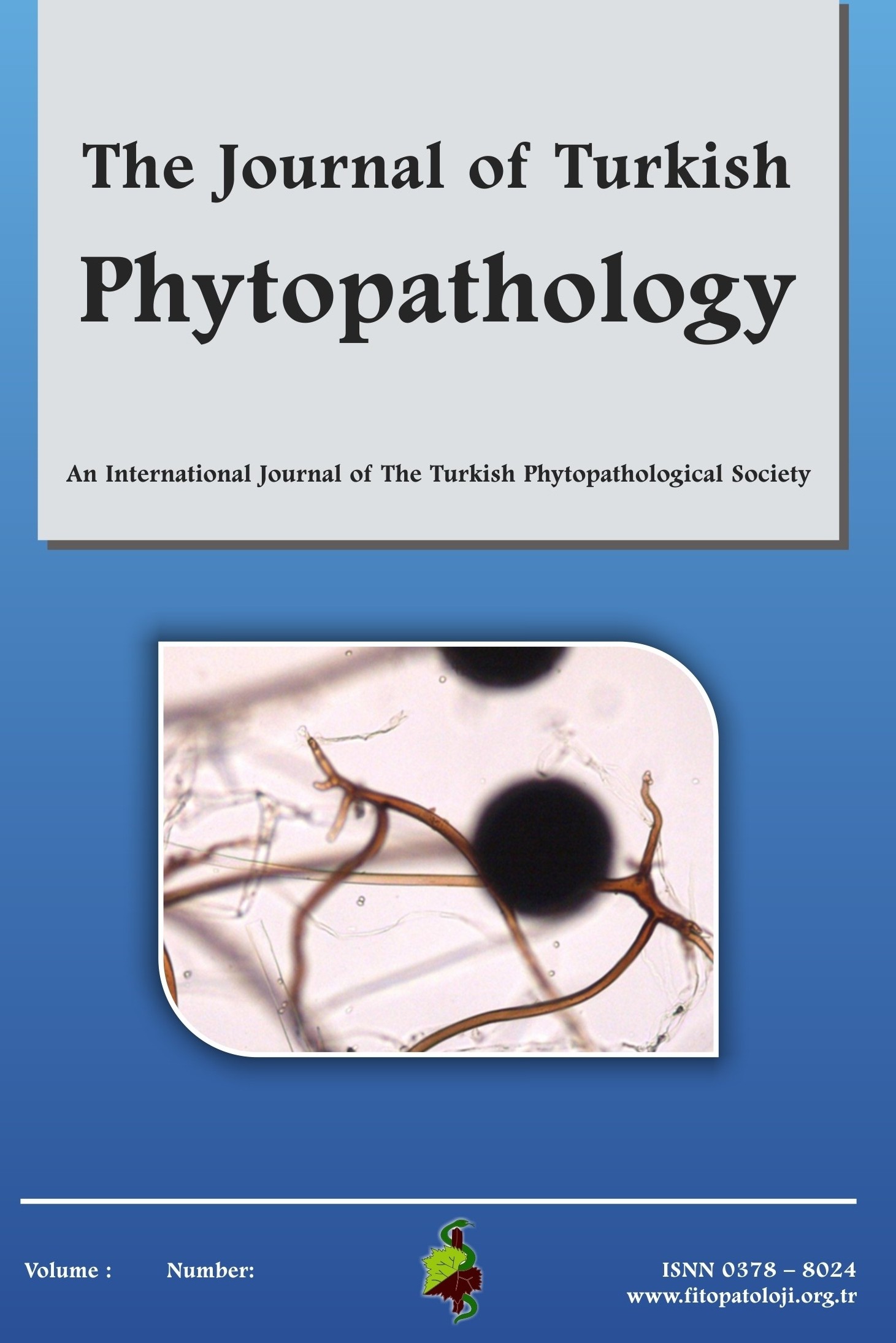Cloning and Sequencing of Virus Inhibiting Gene Encoding an Antiviral Protein From the Leaves of Pokeweed (Phytolacca Americana L.)
Cloning and Sequencing of Virus Inhibiting Gene Encoding an Antiviral Protein From the Leaves of Pokeweed (Phytolacca Americana L.)
Pokeweed antiviral protein (PAP) is single-chain
ribosome-inactivating protein (RIP) of Phytolacca
americana L.
(Pokeweed) that is characterized by its ability to depurinate ribosomes. In the
present study, we cloned and sequenced complete gene of pokeweed antiviral
protein type 1 (PAP-I) from the summer leaves of pokeweed collected from
Trabzon (Turkey) using a pair of gene specific primers based on the known N-
and C-terminal nucleotide sequences of PAP gene. A product of 942 base pair was
purified and inserted into pGEM-T Easy vector (Promega), downstream of the T7
promoter, and transformed into E. coli strain, JM 109. The PAP-I cistron
of P. americana contained 313 amino acid
residues. The DNA sequence of 942 base pairs included an open reading frame
(ORF). The nucleotide sequences of PAP-I gene contained no introns and the
comparison with the PAP-I sequence with the PAP isoform, showed an identity of
80-99%. Sequence analysis of PAP-I revealed that it contains a single point
mutation, changing the Leucine (L) at position 273 to Phenylalanine (F) (L273F)
at the putative active site.
Keywords:
antiviral proteins characterization, cloning, PAP-I gene, phytolacca americana,
___
- Aron, G.M. and Irvin, J.D. 1980. Inhibition of herpes simplex virus multiplication by the pokeweed antiviral protein. Antimicrobial Agents and Chemotherapy.17:1032–1033. Barbieri, L.,Valbonesi, P., Bonora, E., Gorini, P., Bolognesi, A. and Stirpe, F. 1997. Polynucleotide:adenosine glycosidase activity of ribosome-inactivating proteins: effect on DNA, RNA and poly (A). Nucleic Acids Research. 25:518–522. Bijal, A., Parikh, C.C. and Tumer, N.E. 2002. Pokeweed Antiviral protein regulates the stability of its own mRNA by a mechanism that requires depurination but can be separated from depurination of the alpha-sarcin/ricin loop of rRNA. The Journal of Biological Chemistry. 277:41428–41437. Dore, J. M., Gras, E., Depierre, F. and Wijdens, J. 1993. Mutations dissociating the inhibitory activity of the pokeweed antiviral protein on eukaryote translation and Escherichia coli growth. Nucleic Acids Res.21, 4200–4205. Endo, Y., Tsurugi, K.and Lambert, J.M. 1988. The site of action of six different ribosome-inactivating proteins from plants on eukaryotic ribosomes: the RNA N-glycosidase activity of the proteins. Biochemical and Biophysical Research Communications.150:1032–1036. Foà-Tomasi, L., Campadelli-Fiume, G., Barbieri, L.and Stirpe, F. 1982. Effect of ribosome-inactivating proteins on virus-infected cells. Inhibition of virus multiplication and of protein synthesis. Archives of Virology. 71 (4):323–332. Hartley, M.R., Legname, G., Osborn, R., Chen, Z.and Lord, J.M. 1991.Single-chain ribosome inactivating proteins from plants depurinate Escherichia coli 23S ribosomal RNA. FEBS Letters.290: 65–68. Houston, L.L., Ramakrishnanz, S.and Hermodsong, M.A. 1983. Seasonal variations in different forms of pokeweed antiviral protein a potent inactivator of ribosomes. Journal of Biological Chemistry. 258:9601–9604. Hudak, K.A., Dinman, J.D. andTumer, N.E. 1999. Pokeweed antiviral protein accesses ribosomes by binding to L3. Journal of Biological Chemistry. 274:3859–3864. Gendron, Y., and Kassanis, B. 1954. The importance of the host species in determining the action of virus inhibitors. Irvin, J.D.andUckun, F.M. 1992.Pokeweed antiviral protein: ribosome inactivation and therapeutic applications. Pharmacology & Therapeutics55:279–302. Kataoka, J., Habuka,N., Furruno, M., Miyano, M., Takanami,Y.and Koiwai, A. 1991. A sequence of Mirabilis antiviral protein (MAP), a ribosome inactivating protein with an antiviral property, from Mirablis jalapa L. andits expression in E. coli. Journal of Biological Chemistry. 266: 8426–8430. Lin, Q., Chen, Z.C.,Antoniw, J.F. and White, R.F. 1991. Isolation and characterization of cDNA clone encoding the anti-viral protein from Phytolacca americana. Plant Molecular Biology.17: 609–614. Lodge, J.K., Kaniewski, W.K. and Tumer, N.E. 1993.Broad-spectrum virus resistance in transgenic plants expressing pokeweed antiviral protein. Proceedings of National Academy of Sciences of USA. 90:7089–7093. Nicolas, E., Beggs, J.M., Haltiwanger, B.M. andTaraschi, T.F. 1998. A new class of DNA glycosylase/apurinic/apyrimidiniclyases that act on specific adenines in single-stranded DNA. Journal of Biological Chemistry. 273:17216–17220. Poyet, J.L. and Hoeveler, A. 1997. cDNA cloning and expression of pokeweed antiviral protein from seeds in Escherichia coli and its inhibition of protein synthesis in vitro. FEBS Letters.406: 97–100. Rajamohan, F., Engstrom, C.R., Denton, T.J., Engen, L.A., Kourinov, I.andUckun, F.M. 1999.High-level expression and purification of biologically active recombinant pokeweed antiviral protein.Protein Expression and Purification. 16:359–368. Rajesh, S., Balasaraswathi, R., Doraisamy, S.and Sadasivam, S. 2005. Synthesis and cloning of cDNA encoding an antiviral protein from the leaves of Bougainvillea spectabilis Willd. (Nyctaginaceae). World Journal of Agricultural Sciences. 1: 101–104. Song, S.K., Choi, Y., Moon, Y.H., Kim, S.G., Choi, Y.D. and Lee, J.S. 2000.Systemic induction of a Phytolacca incularis antiviral protein gene by mechanical wounding, jasmonic acid, and abscisic acid. Plant Molecular Biology.43: 439–450. Stevens, W.A., Spurdon, C., Onyon, L.J. and Stirpe, F. 1981.Effect of inhibitors of protein synthesis from plants on tobacco mosaic virus infection. Experientia. 37:257–259. Stirpe, F. and Barbieri, L. 1986. Ribosome-inactivating proteins up to date. FEBS Letters. 195: 1-8. Tomlinson, J.A., Walker, V.M., Flewett, T.H. and Barclay, G.R. 1974. The inhibition of infection by cucumber mosaic virus and influenza virus by extracts from Phytolacca americana. Journal of General Virology. 22:225–232. Ussery, M.A., Irvin, J.D. and Hardesty, B. 1977. Inhibition of poliovirus replication by a plant antiviral peptide. Annuals of the New York Academy of Sciences. 284:431–440. Wang, P. and Tumer, N.E. 1999. Pokeweed antiviral protein cleaves double-stranded supercoiled DNA using the same active site required to depurinater RNA. Nucleic Acids Research.27:1900–1905. Waurzyniak, B., Schneider, E.A., Tumer, N., Yanishevski, Y.R., Gunther, L.M., Chelstrom, H., Wendorf, D.E., Myers, J.D., Irvin, Y., Messinger, O., Zeren, T., Langlie,M.C., Evans, W.E. and Uckun, F.M. 1997. In vivo toxicity, pharmacokinetics, and antileukemic activity of TXU (Anti-CD7)-pokeweed antiviral protein immunotoxin. Clinical Cancer Research.3: 881–890. Xu, J., 1997. Pokeweed antiviral protein gene: expression and applications, PhD thesis. Department of Botany, University of Toronto, Canada. Zarling, J.M., Moran, P.A., Haffar, O., Sias, J., Richman, D.D., Spina, C.A., Myers, D.E., Kuebelbeck, V., Ledbetter, J.A.and Uckun, F.M. 1990. Inhibition of HIV replication by pokeweed antiviral protein targeted to CD4+ cells by monoclonal antibodies. Nature.347:92–95.
- ISSN: 0378-8024
- Yayın Aralığı: Yılda 3 Sayı
- Başlangıç: 1971
- Yayıncı: Türkiye Fitopatoloji Derneği
